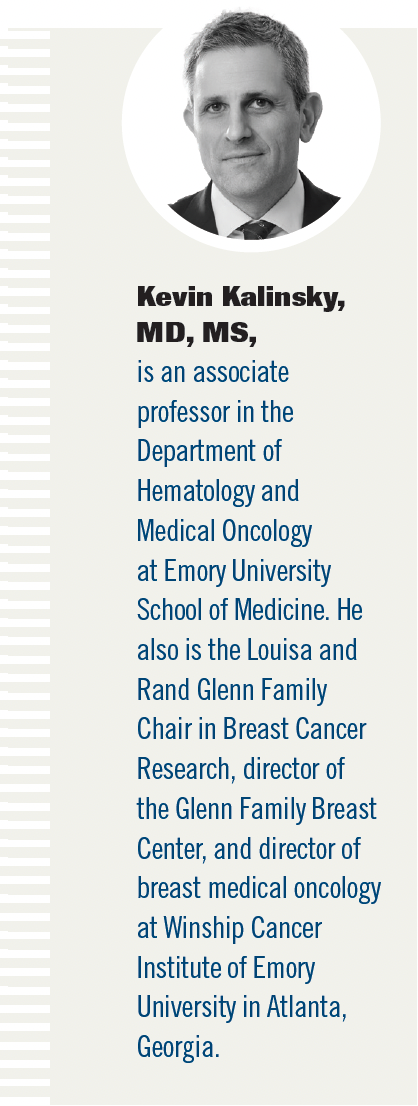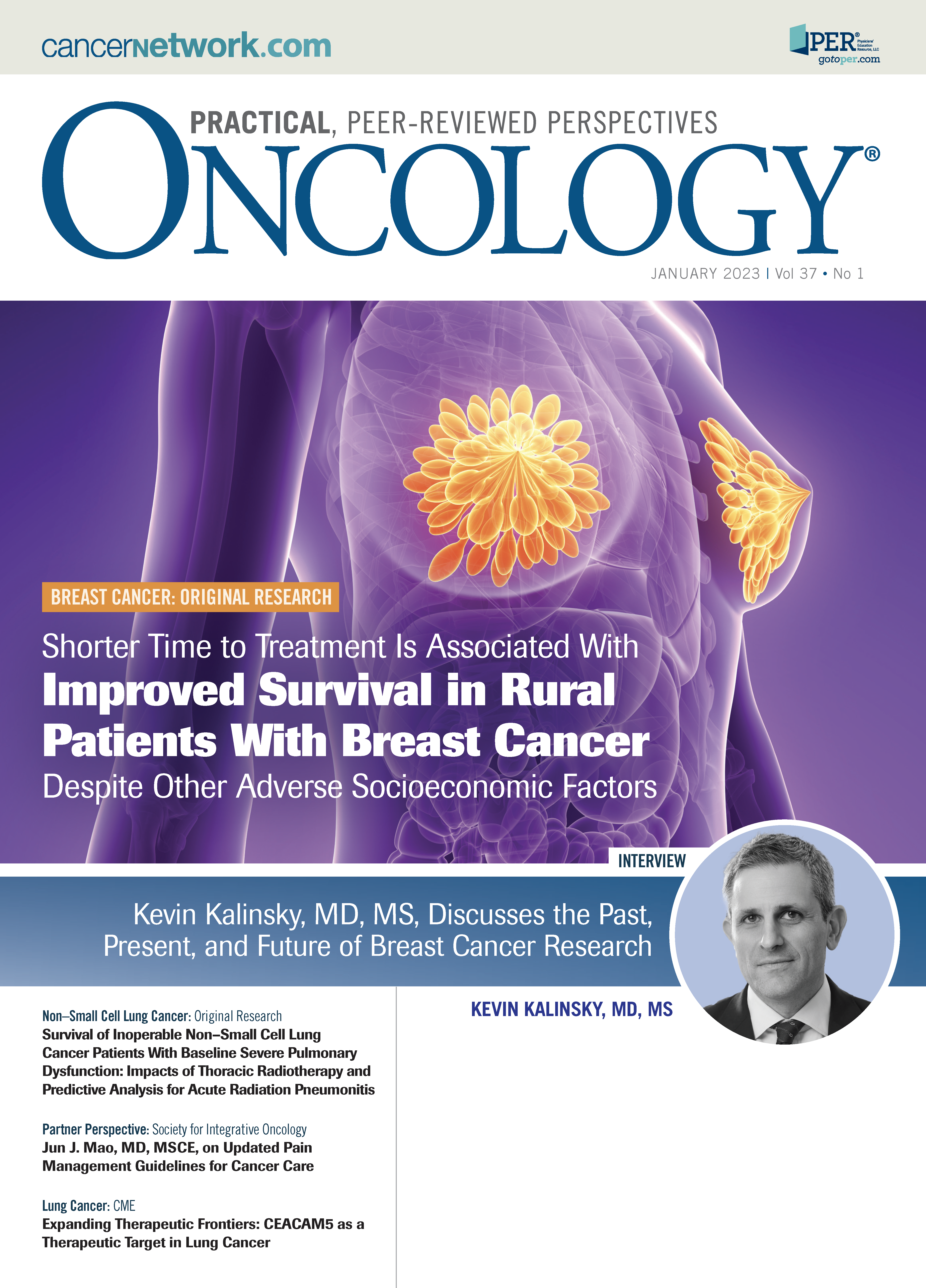Kevin Kalinsky, MD, MS, Discusses the Past, Present, and Future of Breast Cancer Research
“Nonetheless, we saw tremendous benefits for these patients, patients who didn’t benefit from other treatments, and it was exciting to be involved with this early research.”

Developments in the field of breast cancer abounded in 2022, not the least of which were the dramatic results of the phase 3 DESTINY-Breast04 trial (NCT03734029). However, challenges remain copious, and research efforts promise to refine the options available to clinicians across different patient groups. A diverse amount of therapies and agents, coupled with a deeper knowledge of breast cancer subtypes, may allow greater personalization of treatment for patients.
In a recent interview with ONCOLOGY®, Kevin Kalinsky, MD, MS, spoke about developments in breast cancer, some of the most crucial changes to standards of care, and research on the horizon for 2023. He touched on some of the antibody-drug conjugates (ADCs) and CDK4/6 inhibitors currently under review and the potential implications for clinical practice.
Q: What are some of the notable therapies you’ve worked with in clinical research?
KALINSKY: One of my most meaningful experiences [in clinical research] was being an early investigator into sacituzumab govitecan-hziy [Trodelvy]. We participated in the phase 1/2 trial [NCT01631552] that led to its initial approval in patients with metastatic triple-negative breast cancer [TNBC].1 It was a meaningful experience because we could watch patients who hadn’t benefited much from other treatments benefit from [sacituzumab govitecan] in real time. The drug was reasonably well tolerated [but did have some] adverse effects we often see with sacituzumab: diarrhea, fatigue, and sometimes [reduced] blood cell counts.2 Nonetheless, we saw tremendous benefits for these patients, patients who didn’t benefit from other treatments, and it was exciting to be involved with this early research. Sacituzumab govitecan later received a full [FDA] approval based upon the randomized phase 3 ASCENT trial [NCT02574455], which showed the same level of response and overall survival [OS] benefit vs standard of care chemotherapy.3
This approval was for patients with metastatic TNBC. We were also involved in the basket trial examining [sacituzumab govitecan in] patients with hormone receptor [HR]–positive, HER2-negative disease, and we’ve now seen from the phase 3 TROPiCS-02 study [NCT03901339] that there’s an OS advantage with this drug vs physician’s-choice chemotherapy.4
Q: Can you tell me about the phase 3 RxPONDER trial [NCT01272037]?
KALINSKY: One of the greatest unmet needs has been [the difficulty of determining] which patients need chemotherapy. We want patients to be able to opt out of treatments they don’t need [to avoid] unnecessary toxicity. We know lymph node involvement is an independent predictor of risk. When I was a resident studying for the boards, a patient with lymph node–positive breast cancer [always] received chemotherapy. That was the standard.
RxPONDER was conducted based on another prospective retrospective analysis of clinical data, the phase 3 SWOG-8814 trial [NCT00929591]. This was a pivotal study led by Kathy S. Albain, MD, that demonstrated the potential benefit of anthracycline-based chemotherapy. It also demonstrated that there may be a role for oncotype in the determination of risk.5
In RxPONDER, we randomly assigned patients with a recurrence score between 0 and 25 to receive or not receive chemotherapy. All patients received endocrine therapy. Ultimately, for postmenopausal patients with 1 to 3 involved nodes and HER2-negative disease, there was no benefit to chemotherapy. That group included two-thirds of the [total] population, so this is a very meaningful outcome.6
[As a result], we can now avoid those unnecessary toxicities and costs for thousands of patients who fit these criteria. And when I say costs, I also mean the quality-of-life costs that can be associated with chemotherapy.
For the remaining one-third of patients who are premenopausal, we’re still seeing a benefit from chemotherapy, but this is where the greatest [lingering] questions lie. What is [the nature of] that benefit? Does it occur because there are patients stuck having their periods, or is there a relevant difference in the biology of pre- and postmenopausal patients? This remains unanswered. There’s a study planned by NRG Oncology that will help address this question.
At the 2022 San Antonio Breast Cancer Symposium [SABCS], [we presented data showing] that HER2 expression was not related to outcome.7 HER2-low disease is of significant interest in the field now, especially for metastatic disease, given the approval of fam-trastuzumab deruxtecan-nxki [Enhertu].
There were also outcome differences between non-Hispanic White and non-Hispanic Black patients that will likely cause some discussion. Non-Hispanic Black patients seemed to experience worse outcomes despite having equivalent levels of adherence to endocrine therapy in the first year. This [disparity] is hypothesis generating: Why are we seeing this? Is it correlated to differences in access to care? We also [have to proceed with] the understanding that non-Hispanic Black patients remain [broadly] underrepresented in clinical trials. But this disparity remains a critical question.
Q: What are some other unmet needs in breast cancer?
KALINSKY: Patients with HR-positive, HER2-negative breast cancer can have late recurrences, meaning recurrences after 5 years. The question is: How can we identify who those patients are? One avenue of research focuses on circulating biomarkers, such as circulating tumor DNA [ctDNA], to determine who might be at risk for recurrence. We have an ongoing substudy of RxPONDER [in which we’re] collecting blood markers such as ctDNA from patients who haven’t yet had a recurrence and are less than 8 years out from randomization to see if we can find indicators for late recurrence.
Moreover, [another question is]: Are these markers simply prognostic or are they predictive? Would they enable you to change an agent and maybe [use] a new hormonal therapy, such as an oral selective estrogen receptor degrader? Would [this kind of treatment] change the biology of the cancer? These are all [lingering questions].
Q: Is there a problematic scarcity of genomic testing in this breast cancer space?
KALINSKY: The genomic assays for [HR-positive/HER2-negative] breast cancer have been commercially available since the mid-2000s. Some clinicians made use of these tools in patients with node-positive breast cancer before we even had the data, [when] we didn’t know what to do. There are generalizability issues; even in RxPONDER, there wasn’t a large population of patients with tumors greater than 5 cm. Most of the patients had 1 involved node, and less than 10% had 3. So there’s always nuance. Differences in practice patterns [surrounding genomic testing] are primarily based on how to interpret results, as opposed to conducting vs not conducting the test.
Q: What are some up-and-coming biomarkers on the horizon?
KALINSKY: The [major] lingering questions concern the role of circulating biomarkers because tumor biomarkers are static. What has the greatest utility in the early-stage treatment setting? [Should we rely on] bespoke markers for minimal residual disease? For those, you examine the tumor tissue and then look for specific alterations in the blood based on what you see in the tissue. Can [we instead rely on] tissue-agnostic markers?
Again, though, the [crucial] question is: How do you respond to the results? Can you [use them] to change outcomes? That’s the next frontier.
Q: What research was most significant in 2022?
KALINSKY: In HER2-low breast cancer, the game changer this year was the DESTINY-Breast04 trial.
There was also the phase 2 MAINTAIN study [NCT02632045] examining [the benefit of remaining on the] CDK4/6 inhibitor ribociclib [Kisqali] after prior treatment with said inhibitor in the metastatic setting.8 Most of the patients we assessed had received prior palbociclib [Ibrance], and [we found that] after switching their endocrine therapy upon progression, [those randomized to receive] ribociclib had a statistically significant improvement in median progression-free survival vs those who received placebo.
I’m also leading the ongoing phase 3 postMONARCH study [NCT05169567], which is [randomly assigning] patients who progressed on any CDK4/6 inhibitor to receive fulvestrant with or without abemaciclib [Verzenio]. This will be another definitive step toward understanding the efficacy of a further CKD4/6 inhibitor after prior CDK4/6 inhibition.
Q: Are there any trials publishing data early next year that you’re excited about?
KALINSKY: We’ve already seen benefit from using ADCs such as sacituzumab govitecan and trastuzumab deruxtecan. In 2023, I hope to see additional data from these ADC studies. I can’t quite forecast what will read out, but we’re awaiting results from various phase 3 trials that have the potential to be practice changing.
REFERENCES
- FDA grants accelerated approval to sacituzumab govitecan-hziy for metastatic triple negative breast cancer. News release. FDA. April 22, 2020. Accessed December 5, 2022. https://bit.ly/3Fq2nqT
- Kalinsky K, Diamond JR, Vahdat LT, et al. Sacituzumab govitecan in previously treated hormone receptor-positive/HER2-negative metastatic breast cancer: final results from a phase I/II, single-arm, basket trial. Ann Oncol. 2020;31(12):1709-1718. doi:10.1016/j.annonc.2020.09.004
- FDA grants regular approval to sacituzumab govitecan for triple-negative breast cancer. News release. FDA. April 8, 2021. Accessed December 5, 2022. https://bit.ly/3Bd7mbY
- Rugo HS, Bardia A, Marmé J, et al. Overall survival (OS) results from the phase III TROPiCS-02 study of sacituzumab govitecan (SG) vs treatment of physician's choice (TPC) in patients (pts) with HR+/HER2- metastatic breast cancer (mBC). Ann Oncol. 2022;33(suppl 7):S808-S869. doi:10.1016/annonc/annonc1089
- Albain KS, Barlow WE, Shak S, et al; Breast Cancer Intergroup of North America. Prognostic and predictive value of the 21-gene recurrence score assay in postmenopausal women with node-positive, estrogen-receptor-positive breast cancer on chemotherapy: a retrospective analysis of a randomised trial. Lancet Oncol. 2010;11(1):55-65. doi:10.1016/S1470-2045(09)70314-6
- Kalinsky K, Barlow WE, Gralow JR, et al. 21-gene assay to inform chemotherapy benefit in node-positive breast cancer. N Engl J Med. 2021;385(25):2336-2347. doi:10.1056/NEJMoa2108873
- Spring LM, Barlow WE, Bardia A, et al. HER2-19: impact of HER2 low status on clinical outcomes in participants with 1-3 positive lymph nodes, HR+/HER2- breast cancer with recurrence score. Presented at: 2022 San Antonio Breast Cancer Symposium; December 6-10, 2022; San Antonio, TX. Abstract HER2-19.
- Kalinsky K, Accordino MK, Chiuzan C, et al. A randomized, phase II trial of fulvestrant or exemestane with or without ribociclib after progression on anti-estrogen therapy plus cyclin-dependent kinase 4/6 inhibition (CDK 4/6i) in patients (pts) with unresectable or hormone receptor–positive (HR+), HER2-negative metastatic breast cancer (MBC): MAINTAIN trial. J Clin Oncol. 2022;40(suppl 17):LBA1004. doi:10.1200/JCO.2022.40.17_suppl.LBA1004
